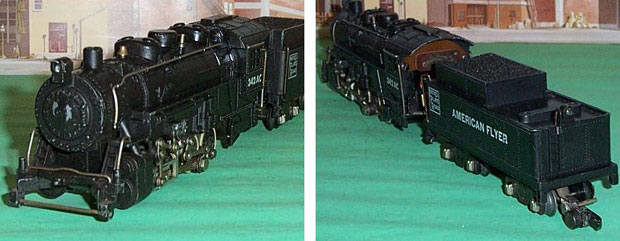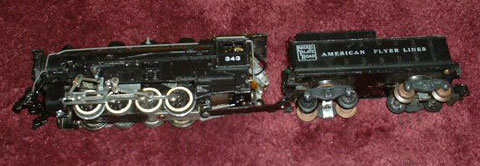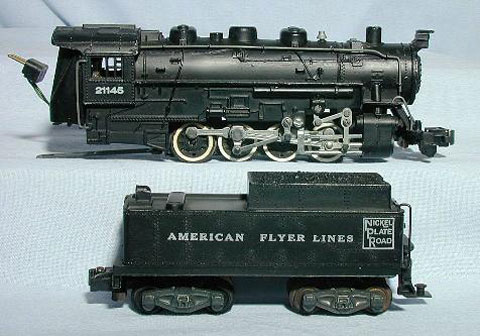If you have a picture that you would like to share with the world of any of engines not shown here, or a better picture of one that is shown, email them to me: theupstairstrain@gmail.com
When I get the pages built, you will be able to click on an engine to see the train(s) it pulled.
Also unlike other American Flyer steam engines, all these switchers had a four-piece diecast body. Gilbert never made one in plastic and never simplified the design to manufacture it in fewer pieces.
The first four #342 Switchers made are quite rare:
- A small number were made in 1946 with smoke unit in the tender and no AF on tender; extremely rare.
- A preproduction prototype with smoke unit in the boiler was made in 1947.

Its smoke unit is in the tender. (Picture courtesy of an anonymous donor.)

(Photo courtesy of Don Hasenzahl.)

(Picture courtesy of an anonymous donor.)

(Photo courtesy of Don Hasenzahl.)

Since there's no box around the Nickel Plate Road herald, you know it was made between 1946 and 1948.
"American Flyer Lines" on the tender says it's 1947 or 1948.
Smoke is tender says it's 1946 or 1947.
That means it was made in 1947, right?
Now look at the coupler.
Thick shank with black weight says 1949 to 1952, late 1948 at the earliest.
Conclusion: we don't know for sure.
It is either a smoke in tender model made in late 1948 or early 1949 to use up parts inventory,
or it was made in 1947 but someone changed the coupler after 1948.
(Picture courtesy of an anonymous donor.)

(Two pictures above and below courtesy of Stout Auctions.)


(Three pictures above and below courtesy of Robert Lear.)



In this picture, you can see the link bar in the front of the engine.
This enabled it to pull cars in switching operations.
All the link coupler switchers had this link bar; the later knuckle coupler engines had a coupler in front.
(Picture courtesy of an anonymous donor.)

(Picture courtesy of Ed Church.)



(Picture courtesy of an anonymous donor.)

(Picture courtesy of an anonymous donor.)

(Picture courtesy of an anonymous donor.)
It takes time and money to maintain a
website like this. If this site is interesting and helpful
to you, please contribute financially to its ongoing success.
You may send a contribution via PayPal using
theupstairstrain@gmail.com as the payee. Both credit card and
direct transfers would be greatly appreciated. Thank you very much.
If you or your friends have some American Flyer
trains and would like them to go to a nice home where they'll be
loved and cared for, this is the place! Email me:
theupstairstrain@gmail.com. See my Wish List
for the items I need most. Thank you very much.
On the other side of the coin, I post pictures from time to time on my
For Sale page of surplus items I have for sale.
This gallery will continue to grow and become more
comprehensive as I collect more cars and as visitors like you send
me pictures of the cars I don't yet have. If you have a car
that you would like to share with the world, email me a picture: theupstairstrain@gmail.com.
Click here for a list of the pictures I need
to complete the Gallery.
The books I am using for reference
are listed in the Bibliography
page. All the writing and all the pictures on this website are, however, my own, except where cited. No
copyrighted materials have been included and all pictures provided
by others are used by permission.
Now show me:
The Gilbert Gallery Home Page
Engines
Passenger Cars
Freight Cars
Freight Sets
Work Cars
Accessories
Infrastructure
Atlantic Steam Engines
Pacific Steam Engines
Hudson Steam Engines
0-8-0 Steam Switchers
Northern Steam Engines
B-6sb Steam Switchers
Dockside Steam Switchers
Casey Jones Steam Engines
Mikado Steam Engines
Berkshire Steam Engines
Challenger Steam Engines
Y-3 Steam Engines
Alco PA Diesel Engines
Geep Diesel Engines
Baldwin Diesel Engines
F-9 Diesel Engines
ES44AC Diesel Engines
SD70ACe Diesel Engines
U33C Diesel Engines
U36C Diesel Engines
GE EP-5 Electric Engines
Handcars
Pictures Needed
Useful Links
For Sale
Wish List
Bibliography
The Upstairs Train